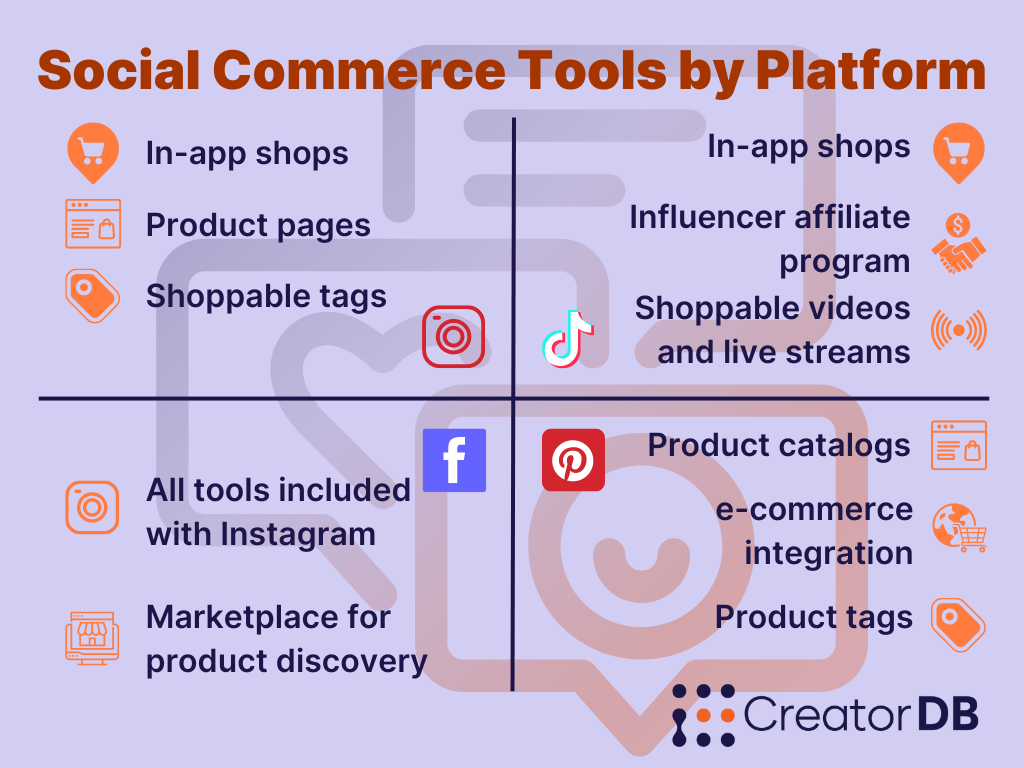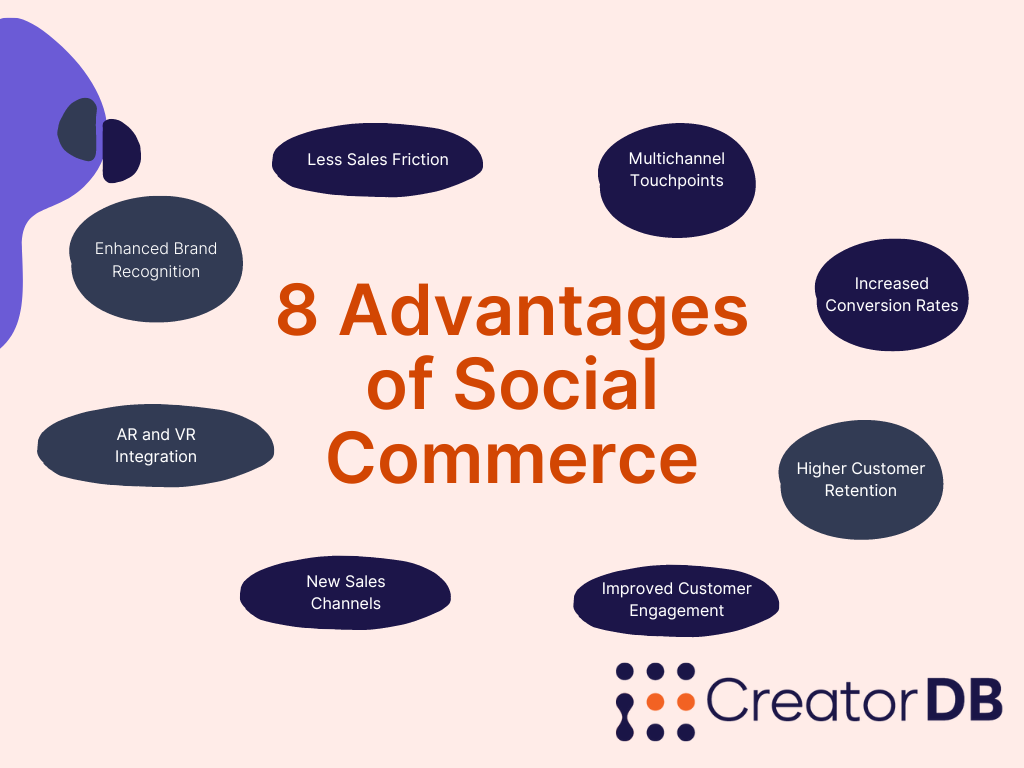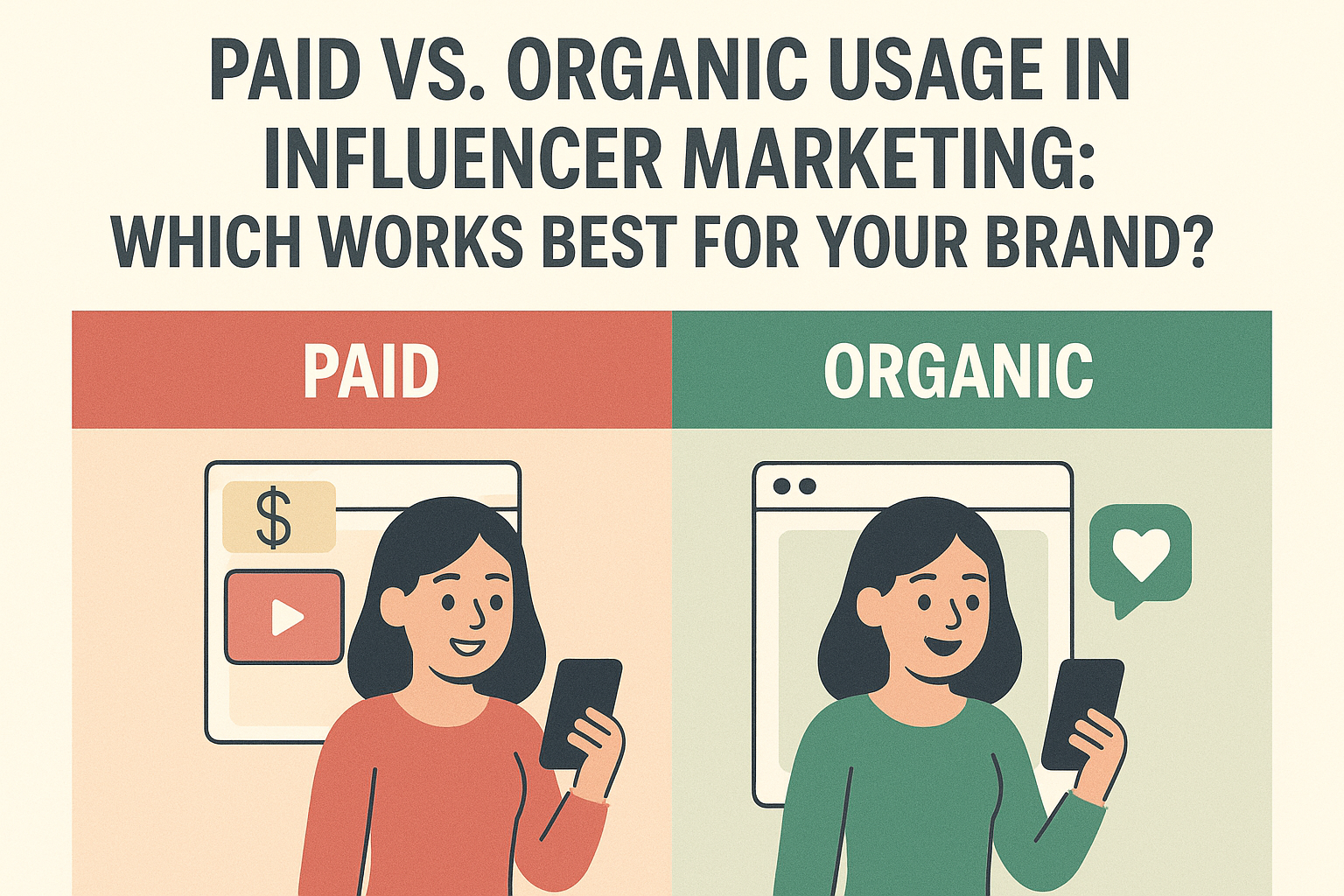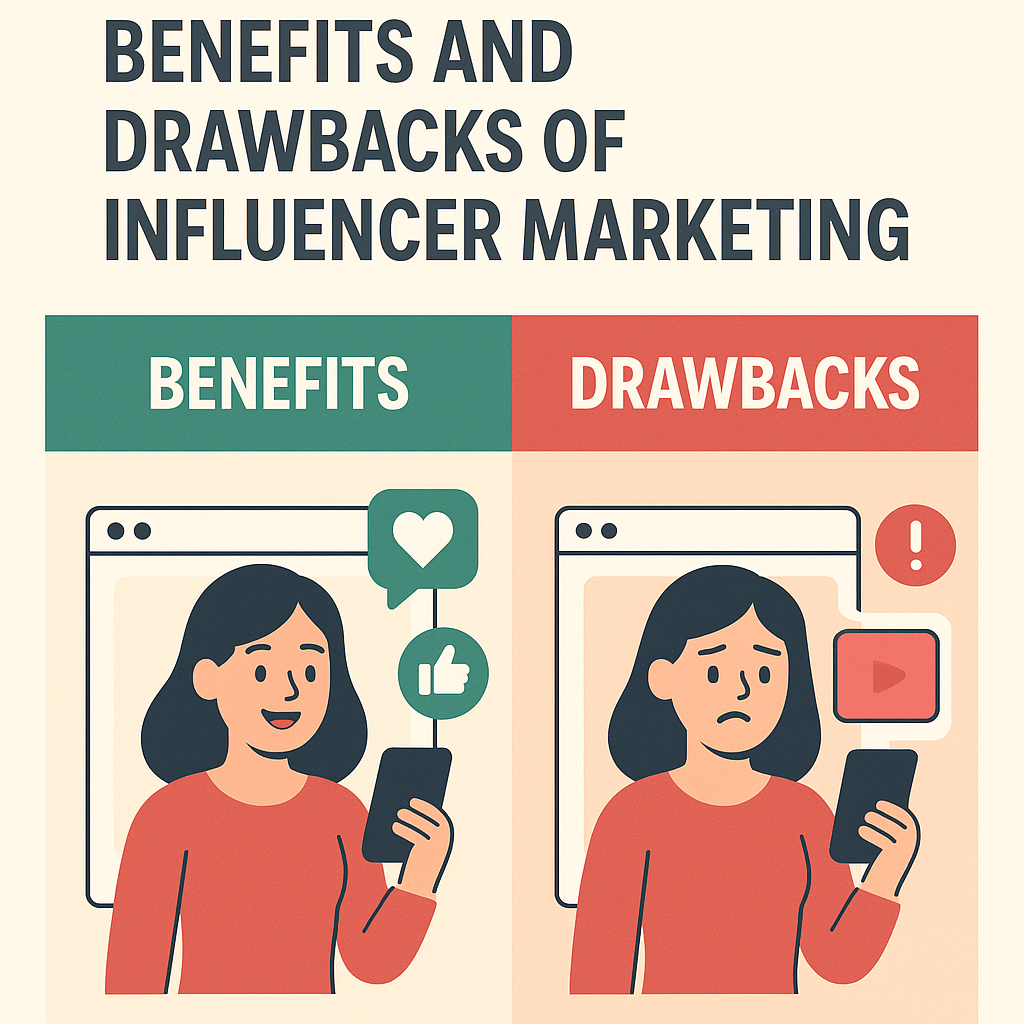The rise of social media has revolutionized how we connect, and now, social commerce will impact how we shop.
Social commerce unites social media and e-commerce to create a smoother and enveloping shopping experience directly from one’s home.
While social shopping native integrations are not yet present on every platform, it is estimated that in 2024, 30% of online shoppers will make at least one purchase through social commerce services. This figure will rise as social commerce options spread across different social media.
Social shopping provides brands new ways to engage with shoppers and smoothens the “discovery through influencer to purchase” pipeline.
This article will explore social commerce and how it shapes online shopping. We will also delve into the role of influencer marketing in social commerce and examine its impact on how consumers interact with brands and make purchasing decisions.
What is Social Commerce
Social commerce is the fusion of social media and e-commerce. It refers to social media introducing tools that allow brands to create shoppable posts, tag products, and build shops directly within the platform. These tools allow consumers to shop and purchase within social media feeds.
The result is a shopping experience that leverages social media platforms’ dynamics to promote product discovery, provide customer support, build brand awareness, and finalize the purchase.
How Big is the Social Commerce Phenomenon
Social commerce is climbing to over 20% of the total e-commerce sector or total revenue of around 1.25 Trillion.
While it is a relatively early phenomenon, many factors point to an expansion trajectory: It is especially suitable for mobile phone shopping, which is prevalent in many critical regions like APAC. Furthermore, it combines brand-owned media (the company profile) with social proof (comments, likes, and influencers’ endorsements) to create a more authentic and trustworthy shopping experience than standard e-commerce.
Social Commerce in APAC
Social shopping is especially prominent in APAC. The region’s high mobile penetration rate and preference for mobile shopping make it a perfect starting ground for this trend. Major social media players like TikTok and e-commerce platforms like Shopee are racing to introduce features like shoppable live streams, influencer collaborations, and flash sales to get a head start on the region’s over one billion potential customers.
Social Commerce VS e-Commerce VS Commerce
Social commerce combines e-commerce and traditional retail to create a new channel for brands to present their products.
Integrating social media in the mix allows the brand to be reachable from anywhere, like in e-commerce, but also to have conversations with new and returning customers and present their product not only through the images and description in a listing.
Before social commerce, social media was among the best-performing marketing channels for many brands, especially small and upcoming ones. Introducing specific tools to smoothen the process from discovery to purchase without leaving the platform improves conversion rates across the board.
Social Commerce and Influencer Marketing
Influencer marketing is behind the efficacy and effectiveness of social commerce. Since creators have been gathering large and engaged followings and marketers have realized the potential of brand-influencer collaborations, it was only a matter of time before the platforms themselves found a way to incentivize and capitalize on them.
Social commerce tools allow influencer marketing to use more accurate and direct tools to track conversions and results.
Social Commerce Platforms
Different social media platforms are implementing social commerce in various ways, providing baskets of tools that may adapt more to some needs than others.
Understanding the strength of each platform is essential when preparing a plan and deciding where to concentrate your brand efforts.
Instagram Shopping
The platform has been photo-centric from the beginning and has always been a great outlet for brands to showcase their products.
Introducing social commerce tools allowed brands to set up their shop with descriptive pages for each product.
Furthermore, shoppable posts include tags for the product sponsored to facilitate its purchase.
TikTok Shops
TikTok shops offer an in-app storefront, easy access to users’ For You page and relevant communities, and an affiliate program to facilitate brand influencer relationships and make them work two ways.
As organic mediums reach the audience, they offer shoppable videos and live streams, making it possible to capitalize on the popularity and live interactions of some of the most viral creators.
Facebook offers the same tools as Instagram: shop pages, product descriptions, and shoppable ads. But it also offers Facebook Marketplace, an entire section of the website where users can search and browse products directly.
Pinterest offers an entirely different approach to social commerce than the other companies.
While offering listings and catalogs to promote your products and the possibility of tagging them in other pins, it does not provide native stores. Instead, it integrates most of the major e-commerce platforms.

8 Advantages of Social Commerce
Increased Brand Recognition
With the typical social media user spending 2 hours and 23 minutes daily on the platforms, it is paramount for brands to be active and project their image to their followers.
Social media also improves the chances that potential customers will stumble upon your brand through organic searches and, potentially, influencer collaborations.
Social media already offers great value for establishing a solid brand by combining an active user base, organic discovery, built-in advertisement tools, and the influencers’ environment. With the introduction of social commerce tools, social media is becoming even more important for new and emerging brands as a place to establish themselves and grow a following.
Decreased Sales Friction
Sales friction is one of the main reasons customers do not complete their purchases. Having to move to a different website to fill the cart, a new registration process, and inserting one’s address or credit card details all constitute a source of friction.
By having a single account that can be used to buy from any brand implementing social commerce, platforms will reduce most of the friction that now happens when purchasing from an ad on social media.
Multichannel Touchpoints
While social media is generally seen as a single entity, it includes very different types of communication that would be seen as completely different channels if they weren’t hosted on the same platform.
The brand’s account is a form of owned media, a perfect way to promote official communications and let potential users hear the brand’s voice.
Meanwhile, influencers are a middle ground between owned media and organic voices. The followers trust them and can be more convincing than the brand messaging.
Finally, there is the true organic discussion: comments, likes, and shares all work towards establishing brand credibility and social proof.
Increased Conversion Rates
One of the primary reasons is that social commerce allows customers to shop in a more relaxed and social environment, where they can connect with friends, family, and other shoppers—not feeling the pressure of deciding and allowing them to ask for familiar people’s opinions easily.
Platforms like Instagram, Facebook, and Pinterest offer a range of features that enable customers to browse and buy products directly from their feeds. These platforms also provide social proof through likes, comments, and shares, which can influence customers’ buying decisions.
For example, when customers see that a product has been liked and shared by many people, they are likelier to trust and buy it themselves.
Another way to increase conversion rates is to provide customers with a more personalized shopping experience. Social media platforms collect data on users’ browsing and purchasing habits, allowing them to show customers products and ads that are more relevant to their interests and preferences. Social commerce can significantly increase conversion rates and drive sales by offering customers products they are more likely to buy.
Higher Customer Retention
Social media platforms offer numerous opportunities for businesses to interact and engage with their customers, which can lead to stronger relationships and increased customer loyalty.
By leveraging social commerce, companies can create a more personalized and interactive shopping experience for their customers, improving their overall satisfaction and likelihood of returning to make future purchases.
One way to help with customer retention is through social media marketing campaigns that focus on building brand awareness and engagement.
Businesses can foster community and trust with their audience by consistently providing valuable content and responding to customer inquiries and feedback. This content, in turn, can lead to increased customer loyalty and retention.
Additionally, social commerce allows businesses to collect valuable data about their customers’ shopping behavior and preferences.
By analyzing this data, companies can gain insights into their customers’ needs and wants and tailor their marketing and sales strategies accordingly. Data understanding can help create a more personalized shopping experience for each customer, increasing their loyalty and likelihood of returning to make future purchases.
Improved Customer Engagement
Social commerce can also enhance customer engagement, an aspect vital for building long-lasting customer relationships.
Businesses can interact with customers in real time by leveraging social media platforms and creating a two-way communication channel. This back-and-forth communication allows companies to address concerns and queries, offer personalized product recommendations, and respond to feedback promptly.
Additionally, social commerce allows customers to share their purchase experiences and product reviews on social media, which can increase brand visibility and credibility.
Social media platforms also effectively create a sense of community among customers.
Businesses can build a loyal customer base invested in their brand.
They can create exclusive social media groups or pages for customers to share their experiences and connect with other like-minded individuals.
Furthermore, businesses can use social media to run contests, quizzes, and other interactive campaigns to keep customers engaged and interested in their brand. These efforts can lead to higher engagement rates, stronger customer relationships, and increased sales.
Emergence of New Sales Channels
Social commerce has given rise to new sales channels, such as live streaming and shoppable videos, which are becoming increasingly popular among consumers.
Live streaming lets retailers showcase their products in real-time and interact with customers through live chat. These broadcasts create a sense of urgency and excitement, encouraging customers to purchase.
Live streaming also allows retailers to build a deeper connection with their audience, which can increase brand loyalty and drive repeat purchases.
Shoppable videos, however, allow customers to shop directly from the video they are watching.
Both shoppable videos and live streams create a seamless and engaging shopping experience. Customers can discover products while watching their favorite content. This type of content is highly shareable on social media platforms, which can help drive brand awareness and attract new customers.
By leveraging these new sales channels, retailers can increase their reach and revenue while providing an innovative shopping experience for their customers.
Use of Augmented Reality and Virtual Reality
Social commerce has also opened the door to using augmented reality (AR) and virtual reality (VR) in commerce.
AR and VR are technologies that can provide customers with an immersive shopping experience. They allow customers to virtually try on products and see how they would look or fit before making a purchase. AR and VR create a more engaging and interactive experience for customers, which can increase their likelihood of making a purchase.
AR and VR technologies can also enhance product descriptions and help customers better understand the products they are interested in.
For example, a furniture store could use AR to show customers how a particular piece of furniture would look in their home. In contrast, a fashion retailer could use VR to create a virtual fitting room where customers can see how different outfits would look on them.
This technology provides customers a more personalized shopping experience and increases the likelihood of a successful purchase. As a result, more and more retailers are incorporating AR and VR into their social commerce strategies to stay ahead of the curve and provide a unique shopping experience for their customers.

Strategies
If you want to do social commerce right, you will need to have a proper strategy in place. Your plan will vary considerably depending on your goals, the established status of the brand, and the use or non-use of influencers.
While in many cases, any of these strategies would be accompanied by sponsored posts and paid media, each platform has different types of sponsored content, and for simplicity’s sake, here, we will only talk about a purely organic approach accompanied by influencers.
Companies Alone
If you don’t want to rely on any influencers, you are your own influencer. You will need to consistently post good and engaging content that features your company and your products to keep the audience’s interest while the algorithms help you expand your follower base.
Established brands can be a bit more relaxed in their posting and still obtain good results while emerging brands need to have a larger content output, especially if they haven’t found a winning type of content yet.
Upcoming brands can expect an unavoidable delay in their results since most customers will need more than one encounter with their material before being convinced to purchase.
With Influencers
Influencers can be a powerful force multiplier for brands that want to engage with their audience from multiple angles and gain exposure and attention quickly and effectively.
Along with organic posting, brands can set up influencer campaigns to connect with their followers authentically and relatable.
Influencers and even affiliates can immensely lower the burden on marketing teams and guarantee highly relevant and high-quality content tailored to the target audience’s unique characteristics if appropriately chosen.
Challenges
Maintaining authenticity and adapting to each platform’s specific characteristics are the two major challenges businesses will face when implementing social commerce strategies. These challenges are diametrically opposed and require a certain level of balance.
Most brands will need some experience and, in some cases, major changes to their plans to overcome these obstacles.
Each platform has its content formats, culture, and etiquette. These all need to be considered when preparing a social commerce strategy. Your brand should go along with them, playing with what is trending and inside jokes.
At the same time, it should not compromise its image. Not every brand needs to take on every new TikTok challenge; only the ones that fit it.
The Future of Social Shopping
Social commerce is growing at a double-digit rate in every key region and is expected to continue for the foreseeable future.
With many social media platforms investing in technologies like AR and VR, AI, and live-shopping experiences, social commerce is expected to rapidly integrate with these new tools to provide an experience that encompasses even more channels.
While it may still seem a new and novel tool, marketers and brand decision-makers need to understand the potential of social commerce and start considering it in their marketing mix.

Find Your
Perfect Influencer
Match Instantly
![The Ultimate Guide To Social Commerce [Platforms, Strategies, & Benefits]](https://www.creatordb.app/wp-content/uploads/The-Ultimate-Guide-To-Social-Commerce-Platforms-Strategies-Benefits.png)





